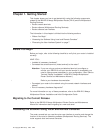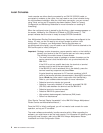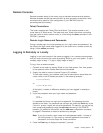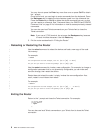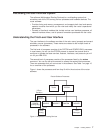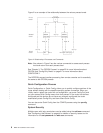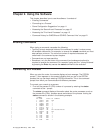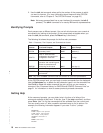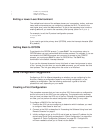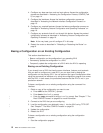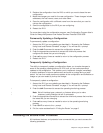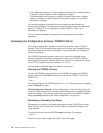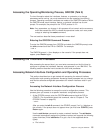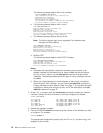
Chapter 2. Using the Software
This chapter describes how to use the software. It consists of:
v “Entering Commands”
v “Connecting to a Process”
v “Some Configuration Suggestions” on page 11
v “Accessing the Second-Level Processes” on page 13
v “Accessing the Third-Level Processes” on page 15
v “Command History for GWCON and CONFIG Command Line” on page 21
Entering Commands
When typing a command, remember the following:
v Type only enough sequential letters of the command to make it unique among
the available commands. For example, to execute the reload command you must
enter rel as a minimum. The minimum number of required characters are
underlined in the command syntax chapters.
v Commands are not case-sensitive.
v Sometimes, only the first letter of the command (and subsequent options) is
required to execute the command. For example, typing s at the * prompt followed
by pressing the Enter key causes the status command to be executed.
Connecting to a Process
When you start the router, the console displays a boot message. The OPCON
prompt (*) then appears on the screen indicating that you are in the OPCON
process and you can begin entering OPCON commands. This is the command
prompt from which you communicate with different processes.
To connect your console to a process:
1. Find out the process ID (PID) number of a process by entering the status
command at the * prompt.
The status command displays information about the router processes, such as
the process IDs (PIDs), process names and status of the process. Issuing the
status command is shown in the following example:
* status
Pid Name Status TTY Comments
1 COpCn1 RDY TTY0
2 Monitr DET --
3 Tasker RDY --
4 MOSDBG DET --
5 CGWCon DET --
6 Config DET --
7 Ezystrt IDL --
8 ROpCn1 IDL TTY1 128.185.210.125
9 ROpCn2 IDL TTY2
10 CES3 IDL --
11 TOUT IDL --
12 L2S3 RDY --
13 L3L2 RDY --
14 LLL2 RDY --
15 S3CE RDY --
© Copyright IBM Corp. 1994, 1998 9
|
|
|
|
|
|
|
|
|
|
|
|
|
|
|
|
|





